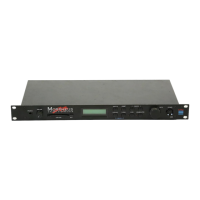Chapter 10: Step-by-Step 149
STEP-BY-STEP
Go back to the Realtime Modulation screen and set it as shown below.
REALTIME CTRL #0
Lfo1 Pan +127
Notice how the LFO now moves the sound from side to side. The dia-
gram below illustrates the connection you just made.
The Realtime Control screen connects ANY realtime modulation
source to ANY realtime control destination! The amount parameter
controls “how much” modulation is applied. Change the destination to
Volume and listen. The block diagram for this connection is shown
below.
Place the cursor under the “#0” on the top line of the display. Turn the
data entry knob and notice that the lower line changes with the patch
number. There are TEN (count 'em) realtime modulation patches avail-
able per preset! This is what sound synthesis is all about. By simulta-
neously controlling many parameters, the sound is shaped in complex
ways into the desired form.
✓␣ Now that you understand how to connect modulation sources to
destinations, try using the Auxiliary Envelope Generator to control
pitch. You've already used the Alternate Volume Envelope generators.
The Auxiliary Envelope works exactly the same, except that it has an
initial Delay stage and it can be routed to any realtime control
destination.
R
L
Pan
Instrument
DCA
LFO 1
R
L
Pan
Instrument
DCA
LFO 1
Vol
••• An LFO modulating
volume is called “Tremolo”.
Tremolo is useful for organ,
voice, surf guitars, etc.
••• You can think of each
modulation patch as a
“Cord”. You must connect
BOTH ends of a cord for it to
work.

